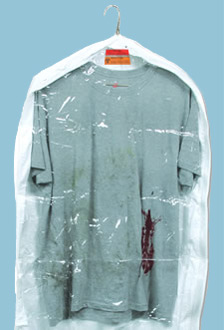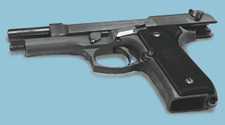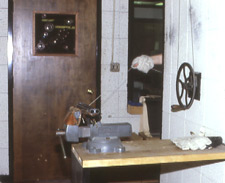Home | Glossary | Resources | Help | Contact Us | Course Map
Archival Notice
This is an archive page that is no longer being updated. It may contain outdated information and links may no longer function as originally intended.
Biohazard Evidence
Body fluids and other human tissue found on firearms evidence pose health concerns to investigators and crime scene technicians in shooting cases. This most often relates to evidence present in or on blood-soaked or stained clothing, bedclothes, furniture, vehicle upholstery, or other items submitted for gunshot residue analysis and muzzle-to-target distance determinations.
In addition to being dry and appropriately packaged before transfer to the laboratory, evidence containing blood or any body fluid should have biohazard warning labels affixed to the evidence containers to indicate that a potentially infectious material may be present. This labeling warns all concerned to avoid direct contact or exposure to potentially infectious evidentiary materials, whether at the crime scene, in investigative offices, or in laboratory and courtroom environments.
In the Laboratory
The rules which follow constitute an additional layer of precautions that must be observed when examining firearms in the laboratory:
- Be aware of all safety policies and procedures of the laboratory and their implementation.
- Examiners are responsible for their own safety and that of others in the working environment.
- Every firearm should be treated and handled as if it were loaded until it has been checked by an examiner.
- When unpacking and inventorying a new firearm evidence submission, it should be assumed that the firearm is loaded. Open the action and ensure that the firearm is in a safe condition and unloaded. Follow the procedure for the particular laboratory regarding the receipt of loaded firearms.
- Any submitted firearm that cannot be readily cleared due to rust or damage should be taken to the range to be cleared.
- Always ensure that the action of a firearm is open when receiving or giving a firearm to anyone.
- Never place unfired ammunition in a firearm at the laboratory bench. If necessary to check the feed mechanism of a firearm, use dummy cartridges.
At the Firing Range
The rules which follow constitute an additional layer of precautions that must be observed when at a firing range, and in particular at the forensic firing range:
- Do not smoke, drink, or eat in any sort of firing facility.
- Wear ear and eye protection when firing.
- Never fire alone.
- Use ventilation systems to remove airborne particulate when firing indoors.
- If unfamiliar with a firearm, ask for advice.
- Be certain that the range backstop and other range surfaces are more than adequate to stop fired bullets.
- When not firing keep the firearm unloaded with the action open and magazine removed.
- Always point the muzzle of a firearm downrange.
- Be certain there is no obstruction in the barrel of a firearm before loading.
- At an outdoor range, never allow the muzzle of a firearm to touch the ground to avoid barrel obstructions.
- Be certain you use ammunition compatible with the evidence firearm.
- If there is any doubt as to the safe condition of a firearm, use a mount or stand for the firearm and arrange to discharge it remotely from a shielded and protected area.
- In the event a firearm was fired during a crime using improper ammunition, use a mount or stand to test fire the firearm remotely from a shielded and protected location.
- Advise others present when you prepare to fire.
- Listen to and comply with range commands if firing in a group.
- In case of a misfire, keep the firearm pointed downrange for at least ten seconds before opening the action.
- Never fire a succeeding shot after a malfunction without first unloading and checking the barrel for an obstruction.
- After firing, be certain to immediately clear a firearm, open the action, and remove any magazine.
Additional Online Courses
- What Every First Responding Officer Should Know About DNA Evidence
- Collecting DNA Evidence at Property Crime Scenes
- DNA – A Prosecutor’s Practice Notebook
- Crime Scene and DNA Basics
- Laboratory Safety Programs
- DNA Amplification
- Population Genetics and Statistics
- Non-STR DNA Markers: SNPs, Y-STRs, LCN and mtDNA
- Firearms Examiner Training
- Forensic DNA Education for Law Enforcement Decisionmakers
- What Every Investigator and Evidence Technician Should Know About DNA Evidence
- Principles of Forensic DNA for Officers of the Court
- Law 101: Legal Guide for the Forensic Expert
- Laboratory Orientation and Testing of Body Fluids and Tissues
- DNA Extraction and Quantitation
- STR Data Analysis and Interpretation
- Communication Skills, Report Writing, and Courtroom Testimony
- Español for Law Enforcement
- Amplified DNA Product Separation for Forensic Analysts




